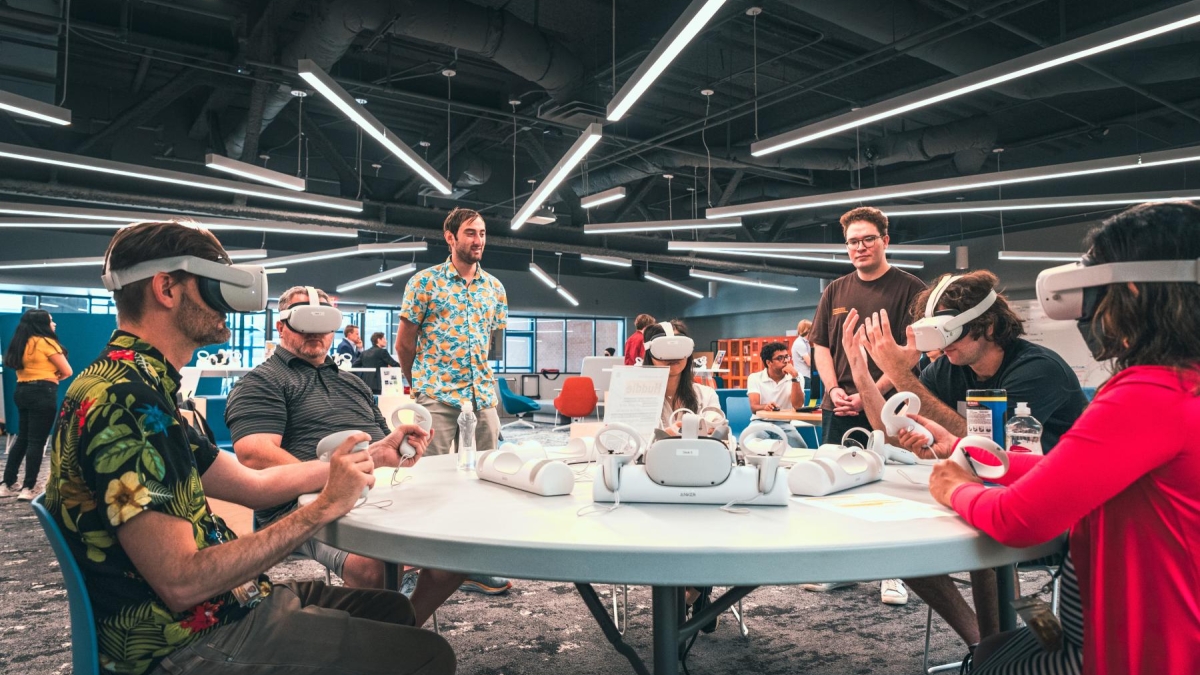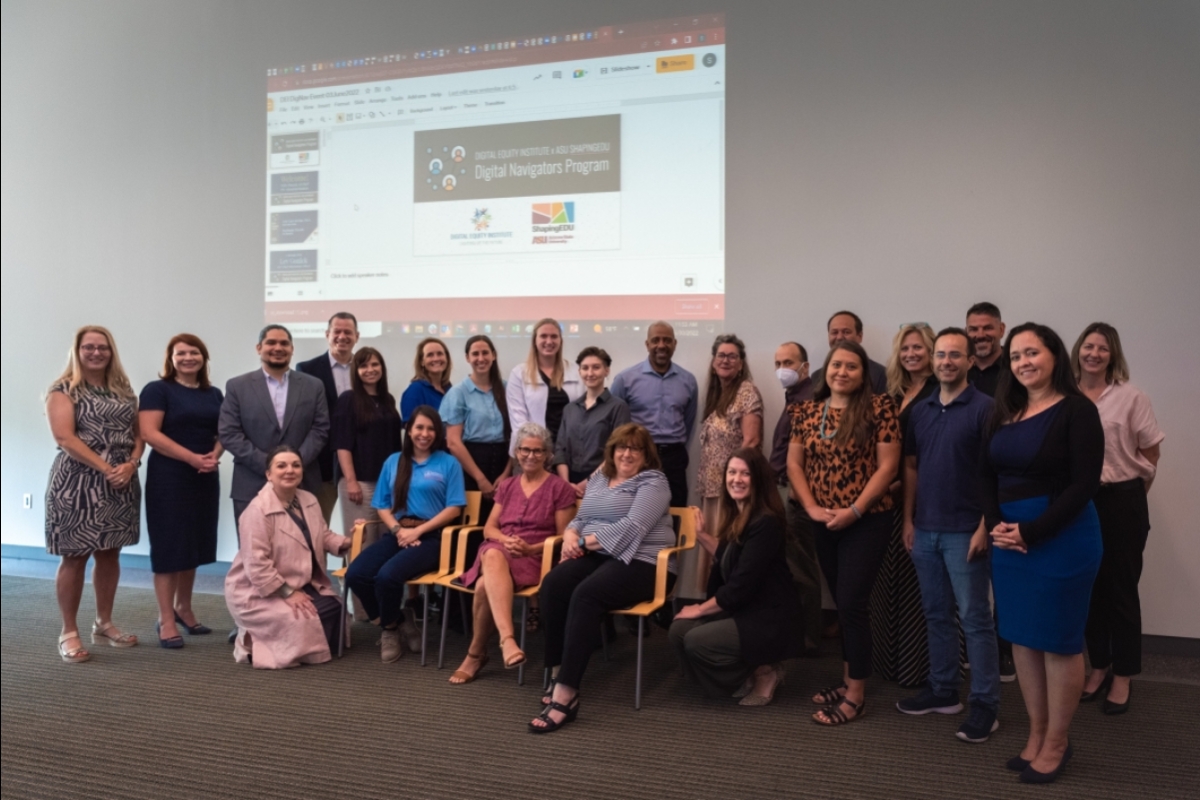In spite of our tendency to break things down into tidy time frames, like a new year or academic semester, change constantly turns over the status quo. Especially in the world of technology, where disruptive innovation may evolve rapidly from the fringe to the mainstream.
“At ASU’s Enterprise Technology, we work in spaces where technology is not just revolutionizing higher education, but the world at large,” said Lev Gonick, chief information officer at Arizona State University. “We strive to be proactive, not reactive, to new paradigms changing the ways in which we work, learn and thrive.”
The following technology trends — as illuminated by Fierce Education (plus one unique to Enterprise Technology) — are what leading technologists, university leadership, the ASU community and beyond are facing today. And not so coincidentally, ASU is on the cutting edge of these educational spaces.
“The world, and by extension ASU learners, are shaped by technologies like those represented here by examples of our work,” Gonick shared.
Trend No. 1 — Artificial intelligence
Artificial intelligence (AI) is having its moment in higher education with the introduction of ChatGPT in the past few weeks. The AI program is gaining attention worldwide with the capacity to produce highly sophisticated writing. With the capability of linear storytelling, identification of fallacies, and grammar and syntax skills, ChatGPT far outclasses the writing AI that has come before it.
Beyond this example, AI is at play in numerous facets of university learning, working and living. In an entrepreneurial and community impact example, students working at ASU’s Learning Futures are using AI technology to provide real-time support to visually impaired students in the classroom. (Learn more about how this group of students is exploring the use of 5G, classroom cameras and artificial intelligence to power the Braille board.)
While higher education leaders are still understanding the impact and implications of such a disruptive technology, ASU is embracing the opportunity to explore this cutting-edge application of AI through the lens of responsible innovation for meaningful impact.
Last year, ASU Enterprise Technology announced a new partnership to become a Verizon 5G Innovation Hub; the partnership brings Verizon’s 5G Ultra Wideband speed to the Creativity Commons at ASU’s Tempe campus.
Trend No. 2 — Chatbots
As an extension of AI principles, digital chatbots simulate human-like conversations with users via text or chat messages.
With one of the most advanced chatbot strategies, ASU is working to find smarter, more meaningful ways to communicate with learners. And one area for impact focuses on financial aid services.
The ASU Experience Center, which provides 24/7 support across various ASU services, now utilizes chatbots to streamline the self-serving student experience and answer financial aid questions faster.
Trend No. 3 — Extended reality
Exploration through education: This is the fourth realm of learning outlined by ASU President Michael Crow that calls for more immersive learning experiences. Technologies like extended reality (XR), virtual reality (VR) and augmented reality (AR) are often used in this space.
Extended reality is a collective term for digital spaces, such as VR and AR. ASU is leading the way in immersive learning experiences through a partnership with Dreamscape Immersive, the world’s leading virtual reality company. Together, the teams have launched Dreamscape Learn, which offers fully immersive VR learning. Last year, for example, students taking introductory biology experienced DSL as part of their learning.
“At ASU, we’re blending real and virtual worlds to effectively remove barriers to where, when and how learning happens,” shared Gonick. “Through the use of technology, we can enhance, amplify and facilitate deeper and more authentic learning experiences.”
Dreamscape Learn is held inside the Creativity Commons on ASU’s Tempe campus. Directly next door is a space where additional XR experiences are being designed and developed for students by students at Learning Futures.
One such project is Huddle, which offers classroom experiences in VR. And last semester, students in HST 130 slipped on the Oculus headset, strapped on the hand controllers and were transported to trenches of World War I inside the Huddle experience.
Trend No. 4 — Digital twins
Simply put, digital twins are virtual representations of an object, system or space. These indistinguishable digital counterparts have been used for decades.
However, building off technology trends noted in the first installment — including virtual reality, artificial intelligence and metaverses — digital twins are having a resurgence.
At ASU, students are developing a digital twin of the campus. The ASUniverse models, in full 3D scale, the architecture, classrooms and even the Southwest landscape of ASU’s Tempe campus, accessible from anywhere. Future use cases of the digital twin include touring the Tempe campus, attending class, enjoying live entertainment and more.
Additionally, the ASU Smart City Cloud Innovation Center, powered by Amazon Web Services, is developing a digital twin of downtown Phoenix for improved and strategic urban planning.
Trend No. 5 — The metaverse
In keeping with the previous two trends in virtual communities, the global metaverse is extending beyond organizational silos to connect people in a digital world. A main mission of the recently established Zoom Innovation Lab at ASU is to extend Zoom into the ASUniverse.
“The first-of-its-kind Zoom Innovation Lab at ASU will combine the resources available across the ASU Public Enterprise — including the university’s expertise, research, networks and learning assets — with Zoom’s technology and talent to create solutions that better connect society,” Gonick shared in a recent interview with Forbes.
Additional opportunities for more immersive experiences inside the ASUniverse include sporting events, telehealth counseling services and more.
Trend No. 6 — Internet of Things
The Internet of Things (IoT) refers to the connection of previously unconnected devices, processes and services to the web and each other. This network of connectedness is often described as “smart,” and aligns with ASU’s high priority to play a leading role in cultivating smart campuses, cities and regions.
“The university has risen as a hotbed of innovation, research and experimentation,” says Gonick in response to the power of partnerships. “Our ability to instrument our campuses' digital infrastructure to support engagement, personalization of learning journeys and public safety are all extensible to meet the needs and priorities of our neighbors.”
At ASU Enterprise Technology, two notable partnerships are helping us advance this work. The Cox Connected Environments Collaboratory tests multiple types of networks to better connect the ASU campus and beyond. Such networks include Bluetooth 5, LoRA (Long Range), CBRS (Citizens Broadband Radio Service) and Cox Optical Internet.
And the Smart City Cloud Innovation Center is helping to lead efforts to advance the use of smart technology from campus to the community. Known as the CIC, the team focuses on using emerging smart technology for local nonprofits and municipalities.
Trend No. 7 — Blockchain
Today, much of the national discussions around blockchain center on cryptocurrencies. However, this breakthrough technology creates new opportunities to reimagine credential management for the learner, institutions and organizations.
Two initiatives are underway at ASU Enterprise Technology to bring credentials into the 21st century using distributed technology, including blockchain. The first focuses on creating a network — both digital infrastructure and community — to build a validated and immutable repository of learning.
To do so, the Trusted Learner Network is working to reimagine the traditional digital credential model by placing learners and their data at the center.
Utilizing distributed, web 3.0 semantic technologies, the Trusted Learner Network creates a durable, immutable ledger of learning that allows learners to easily view and manage their credentials.
And in order for learners to capture their diverse records of learning as verified credentials, they need a digital wallet. Enter ASU Pocket.
The digital wallet and portfolio is being designed and developed by teams at Enterprise Technology. Learners will be able to capture evidence of their learning inside their wallet and connect their skills to future jobs.
Both ASU Pocket and the TLN were featured in the 2023 SmartReport Ecosystem Map, released by iDatafy; the map (included above) reflects a current landscape of digital wallet and learner educational records (LER).
Trend No. 8 — Cloud computing
Over the past few years, ASU has embarked on a massive undertaking to become a fully cloud-based infrastructure.
Cloud computing offers the storage of large datasets at significantly faster speeds with lower costs. That matters in a world that is increasingly moving online, where the amount of data that is available to capture and store continues to grow exponentially.
The cloud allows for a flexible and accessible digital infrastructure capable of evolving to the demands of our community. One such example involves a collaboration with the Arizona Board of Regents and the AZTransfer process for all state schools.
Trend No. 9 — Gamification
In recent years, the development of an interactive, gamified learning community has gained momentum on campus among learners of all backgrounds.
Now, the combination of Sun Devil Rewards, previously a standalone app, with the ASU Mobile App has integrated the playful approach with other helpful, informative services and resources. Creating a one-stop shop for students to connect, navigate campus and more while accumulating Pitchfork points to become eligible for big prizes.
Trend No. 10 — Digital equity
In recent years, digital equity has risen to the national agenda. And while this was not listed in the edtech trends article referenced above, it has surfaced as a unique opportunity for universities to play a critical role in advancing digital inclusion.
“In realizing the aspirations set forth by our charter, the university remains committed to increasing access, excellence and impact for all those we serve — and we know that technology plays a critical role in this mission,” says Gonick. “As such, it is imperative that all have access to reliable, high-speed internet to fully participate in the ways we work, learn and live online.”
A recent $34.6 million investment in ASU and its collaborators from Maricopa County to narrow the digital divide is proof of the importance of this work. The funding will be used to advance broadband, community support, equipment and training across Maricopa County, which includes the metro Phoenix area, bringing reliable, high-speed internet access to under- and unserved communities.
This funding makes ASU home to the largest university-led digital equity initiative in the country.
This exploration of the intersection of higher education and technology is a small window into the consistent changes shephered at ASU Enterprise Technology.
More Science and technology

Research expenditures ranking underscores ASU’s dramatic growth in high-impact science
Arizona State University has surpassed $1 billion in annual research funding for the first time, placing the university among the top 4% of research institutions nationwide, according to the latest…

Programming to predict the unpredictable
As the natural world rapidly changes, humanity relies on having reliable, accurate predictions of its behavior to minimize harmful impacts on society and the ecosystems that sustain it.Ecosystems of…
Findings on adenoviruses in baby gelada monkeys provide a window into our own cold and flu season
If you have young kids or spend time around day care centers, you know the drill: Someone gets a cold, and soon the whole group is sniffling and sneezing. Now imagine that same pattern playing out in…










